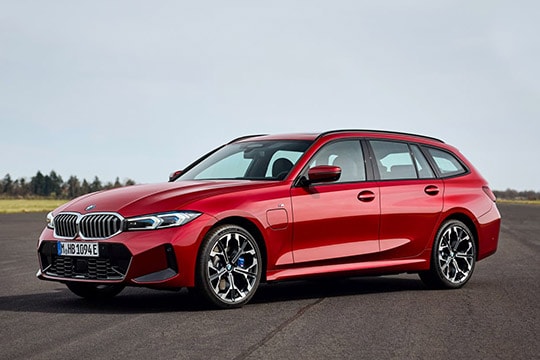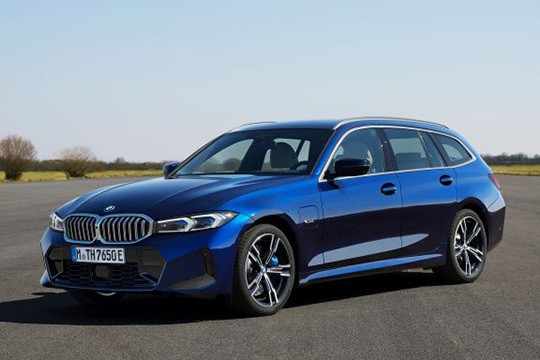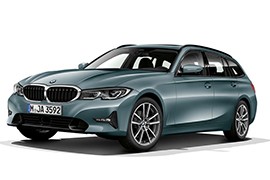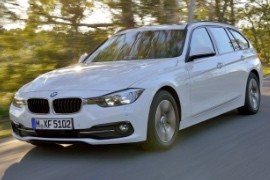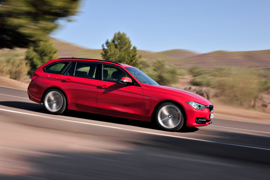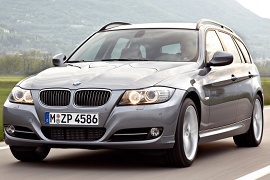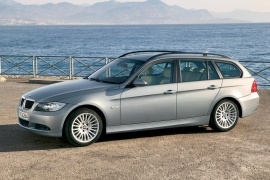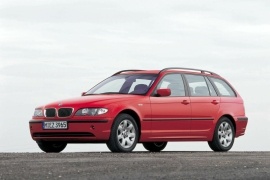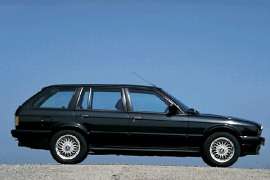BMW 3 Series Touring Models/Series Timeline, Specifications & Photos
First production year: 1988
Engines: Mild hybrid diesel, Gasoline, Hybrid gasoline, Mild hybrid, Diesel
Body style: Wagon (station wagon, estate, combi, touring)
BMW made a surprising move in 2024 when it introduced a second facelift for the 3 Series, an update that affected the entire range, including the station wagon, which was traditionally called the 3 Series Touring.
The German automaker introduced the seventh generation of the 3 Series, known as the G20, in 2018. It was another success story for BMW, and besides the sedan, the station wagon came with advanced and modern features. Still, it kept some unique features, such as the independent opening for the rear window on the tailgate and the roomy interior. This bodywork version used the Touring nameplate and was introduced by the automaker in June 2019. considering the carmaker’s habits, customers expected a facelift for it in 2023. But then, the world pandemic and the microchip happened, hurting sales and affecting the carmaker’s income. As a result, BMW had to adapt, and in May 2022, the 3 Series received an update, also known as Life Cycle Impulse, in the carmaker’s language. The automaker usually made these updates once during a model’s generation, but in this situation, it did two, with the second LCI coming into life in late May 2024, just two years after the previous one.
Along with the updated version, the 3 Series Touring received new LED headlights featuring comma-like daytime running lights. BMW also offered the option for adaptive and Matrix-LEDs, significantly improving the night driving experience. The 3 Series could be fitted with either an M-Package or an M-Package pro, which created a sportier look for the already sporty-looking station wagon. At the front, standard versions featured an angular-looking horizontal kidney grille above the bumper, while the apron sported a broad air intake flanked by vertical scoops for the air curtains that lowered the drag coefficient. Vehicles fitted with the M-Package had broader air intakes and taller side vents. Furthermore, the M-Package Pro added a black trim around the upper grille.
From its profile, the long hood of the car was specific for BMW, which had longitudinally mounted engines. Up to the B-post, it looked identical to its sedan sibling, but afterward, things went differently. The automaker created a slightly sloped down roofline that ended at the back into a raked-forward tailgate adorned at the top by a roof spoiler. Along with this second LCI of the G21 3 Series, the automaker added new options for alloy wheels, ranging between 17- and 19 inches. Out back, the rear bumper sported a black trim on its lower side.
Inside, the automaker installed a curved display that united the instrument panel and the touchscreen for the infotainment system. Along with the 2025 BMW 3 Series Touring, the automaker introduced its newest BMW Operating System 8.5. This included augmented reality and new controls for the HVAC system, with touch sliders permanently kept in the same lower position of the infotainment screen. Customers could customize their vehicles with new M-badged steering wheels featuring a 12-o’clock mark. Besides the standard comfort seats, the 3 Series was available with a set of high-bolstered ones as well. On the center console, the car was available with different trims that surrounded the control panel for the buttons placed there for the automatic transmission, driving modes, and parking brake. In the back, the split-folding bench seat (40/20/40) expanded the trunk from 500 liters (17.7 cu-ft) to 1,510 liters (53.3 cu-ft).
BMW offered the 2025 3 Series Touring with a choice of four gasoline and four diesel engines, all turbocharged. Furthermore, the 330e plug-in version could work in EV mode only for around 101 km (63 miles), dramatically improving fuel efficiency without sacrificing comfort or performance. All engine versions were paired with an eight-speed automatic transmission with an integrated electric motor, which was very efficient for hybrid and mild-hybrid versions.
BMW introduced a facelift for the seventh generation of the well-known 3 Series in the summer of 2022, just three years after the initial launch, and the updates affected both versions of the car, the sedan and the station wagon.
The German automaker didn’t like to call its facelifted models in such a way, preferring the LCI (Life Cycle Impulse) designation instead. Its move came after three gruesome years affected by the 2020 world pandemic 2020 and the microchip crisis that followed. Despite all the obstacles, the seventh generation of the 3 Series was still able to reach its customers in over a million units between the initial unveiling and the July 2022 update. Not only was the car the best-selling generation in the nameplate’s history, but it also accounted for 14 percent of the carmaker’s sales. It was the cash cow of the family. Furthermore, it dominated the compact executive segment in many countries, and BMW tried to keep that winning streak on its plate. There were some noticeable exterior and interior changes and more important updates under the car’s skin.
The 2022 BMW 3 Series Touring received standard LED headlights across the range. In addition, the automaker offered the option for adaptive lights, which included non-dazzling matrix high-beam as well as dynamic headlight range control and variable light distribution. Another significant change was for the daytime running lights, which sported an upside-down L-shape. To match these modifications, BMW also had to redesign the kidney grille, making it look wider than on the non-facelifted variant. The 3 Series was available with a few options for the exterior appearance. Base versions featured a front bumper that resembled the one installed on the 2019 model year, with T-shaped side scoops but with a wider center air intake. In addition, the automaker offered the options for an M Sport package or M Sport package Pro, which added a broad hexagonal lower air intake flanked by rectangular scoops.
From its profile up to the B-pillars, the Touring, also known as the Sports Wagon in the U.S., shared its body panels with the four-door version. However, the longer wheelbase and the extended roof told a different story. They promised more interior room and a wider trunk. BMW didn’t want to trade look for space, so it created a raked forward tailgate for the G21 adorned at the top by a roof spoiler. Even though this solution reduced the loading capacity, it helped the car look more like a shooting brake than a regular station wagon. In addition, the aforementioned visual packages produced by BMW’s M Division made the Touring look faster and more aggressive. It even included aerodynamically profiled side skirts. At the same time, at the back, the rear bumper differed, depending on the packages. Base models featured T-shaped trims, while the M Sport-equipped version received a broad diffuser placed underneath the bumper flanked by vertical fake vents.
Inside, customers were greeted by a completely redesigned dashboard. It featured a curved display, which was a glass panel that covered the 12.3” digital instrument panel and the 14.9” infotainment screen placed atop the center stack. The car could now be paired with Apple CarPlay and Android Auto devices to smooth things out. In addition, an eSIM ensured 5G data transfer. The front seats were the same as in the sedan version, but the rear split-folding (40/20/40) bench seat was different. It could be partially or completely lowered to increase trunk space from 500 liters (17.7 cu-ft) to 1,510 (53.3 cu-ft).
Customers could order the 2022 BMW 3 Series Touring (G21) with a choice of three plug-in hybrids, four gasoline, and four turbodiesel engines. They all sent the power to the standard eight-speed automatic transmission. There was also a choice of five mild-hybrid drivetrains, and several models were available with rear- or all-wheel drive systems.
Introduced in June 2019, the station wagon version of BMW’s 3 Series seventh generation followed in the footsteps of its predecessor and came with a longer wheelbase than its sedan brother.
The seventh generation of the 3 Series was also the sixth for the station wagon version of this nameplate since it was introduced only in the mid-80s as a facelift for this lineup’s second generation, the E30. However, the same thing happened with the four-door sedan and the convertible since the first generation of the 3 Series was available only as a coupe. Regardless of these historical facts, the G21, as it was known in the automaker’s internal coding, was a family vehicle with a healthy dose of sportiness. The new model was built on the CLAR platform shared with other cars from the automaker’s range, such as the 5 and the 7 Series.
From the front, the 2016 BMW 3 Series Touring had narrow headlights with a slight center indentation that emphasized the twin-headlamp design. These were available as full LEDs, while the base versions featured bi-xenon lamps. Between them, the automaker installed a broad kidney grille with chromed surrounding and black or chromed vertical slats, depending on the grade and options. For the lower bumper, BMW offered the choice of either a standard or an M Sport Package for the exterior. The former featured a broad center air intake in the lower side of the bumper flanked by T-shaped side scoops, while the latter had an upside-down three-piece trapezoidal grille flanked by broad air vents that housed lamellar LED fog lamps.
From its profile, the car looked identical to the sedan up to the B-post, but things went a different way behind that point. The station wagon featured a long, sloped-down roof that was continued on the back by a roof spoiler placed atop the center stack. Between the rear doors and the D-posts, the automaker added a narrow window that ended in the already famous Hofmeister-kink design theme. Out back, the full-LED taillights sported the L-shape that BMW implemented across the range. Like its predecessors, the 2019 BMW 3 Series Touring featured an independent open for the rear window, which allowed customers to put smaller items in the trunk without opening the entire tailgate.
Inside, BMW offered customers the option of a digital instrument cluster instead of the standard analog one. Furthermore, all versions came with the iDrive infotainment system shown on a screen placed atop the center stack. On the center tunnel that separated the front occupants, BMW installed the gear stick or the selector for the automatic transmission, several buttons for driving modes (ECO, comfort, sport), parking sensors, and an electric handbrake. In the back, thanks to the longer wheelbase, the F31 provided 11 mm (0.4-inch) more knee room for the rear seated passengers. While this didn’t seem to be too much progress, it came on top of the already enough legroom provided by the sedan. Behind the split-folding (40/20/40) bench seat, the trunk could accommodate up to 500 liters (17.7 cu-ft) of space, which could be extended to 1,510 (53.3 cu-ft) with the rear seats folded down.
BMW installed a wide choice of gasoline and turbodiesel engines under the 2019 3 Series Touring’s hood. Furthermore, there were also options for hybrid and plug-in hybrid versions, which proved to be a better alternative to those looking for fuel-efficient vehicles. Most powerplants could be paired with a six-speed manual or an eight-speed automatic. BMW also offered its well-known xDrive all-wheel drive system for selected versions.
BMW 3 Series Touring (G21) 318d 6MT RWD (150 HP)
BMW 3 Series Touring (G21) 318d 8AT RWD (150 HP)
BMW 3 Series Touring (G21) 320d 6MT FWD (190 HP)
BMW 3 Series Touring (G21) 320d 8AT RWD (190 HP)
BMW 3 Series Touring (G21) 320d xDrive 8AT AWD (190 HP)
Just three years after the introduction of the 3 Series Touring (F31) at the Auto Mobil International Leipzig in 2012, BMW launched the refreshed version of this vehicle.
While it was part of the sixth iteration of the 3 Series, the Touring was one generation short since this family's first station wagon version was introduced in the mid-80s, along with the facelift for the second generation 3 Series, the E30. In the U.S., this version was known as the Sports Wagon and was praised for its qualities not just because it could carry more in its trunk but also because it provided more interior room overall. That happened because it had a 50 mm (2 inches) longer wheelbase than its sedan sibling, and it was also available with unique features such as a panoramic glass roof that could open. BMW introduced the LCI (Life Cycle Impulse) version of the F31, as it was known in factory coding, in 2015 for the 2016 model year. The refreshed version shared most of its underpinnings with its four-door brother but had some particularities.
At the front, the automaker installed a new set of headlights. For the first time in the model’s history, these were available with full LEDs, while its predecessor was offered only with bi-xenon brights. In addition, the new headlamps featured redesigned daytime running lights, which had an angular shape and underlined the high- and low-beam bulbs. Previously, the DRLs were circular. Another noticeable change was for the lower bumper, which received wider side scoops with available fog lamps. As an option, customers could opt for an M Sport package, which was the closest version of an M-badged 3 Series Touring since there was no M3 Touring available.
From its profile up to the B-pillars, the F31 shared its body panels with its four-door sedan sibling. However, after that, things went differently. The car featured a long roof extended above the trunk space and slightly sloped down to create a dynamic, sporty look for the vehicle. At the back, the automaker added a roof spoiler at the top of the raked-forward tailgate. The rear fascia also featured new full-LED taillights that were split between the quarter panels and the metallic part of the tailgate.
Inside, just a few things were upgraded for the 2016 BMW 3 Series Touring. These included a few available black or satin aluminum trims on the dashboard. However, the most significant change was for the infotainment system, which allowed LTE data communication. The new Connected Drive unit helped customers reach their destination faster thanks to real-time traffic information. All versions now featured music streaming via Bluetooth connectivity with mobile phones. Still, there was no Apple CarPlay or Android Auto available since these two systems were launched by Apple and Google, respectively, in 2014. Like its non-facelifted version, the F31 provided 17 mm (0.7 inches) more knee room for its rear-seated passengers. However, the tall transmission tunnel took its toll in that matter and obstructed legroom for the one that sat in the middle.
The 2016 BMW 3 Series Touring was available with a choice of four gasoline and seven turbodiesel engines, depending on the market. In addition, the automaker introduced a plug-in hybrid version, the 330e, which promised excellent fuel efficiency on par with its turbodiesel-powered siblings. Depending on the version, the station wagon could be ordered with rear or all-wheel drive systems.
BMW 3 Series Touring (F31) LCI 316d 6MT RWD (116 HP)
BMW 3 Series Touring (F31) LCI 316d 8AT RWD (116 HP)
BMW 3 Series Touring (F31) LCI 318d 6MT RWD (150 HP)
BMW 3 Series Touring (F31) LCI 318d 8AT RWD (150 HP)
BMW 3 Series Touring (F31) LCI 318d xDrive 6MT AWD (150 HP)
BMW 3 Series Touring (F31) LCI 320d 6MT RWD (190 HP)
BMW 3 Series Touring (F31) LCI 320d 8AT RWD (190 HP)
BMW 3 Series Touring (F31) LCI 320d EfficientDynamics 6MT RWD (163 HP)
BMW 3 Series Touring (F31) LCI 320d EfficientDynamics 8AT RWD (163 HP)
BMW 3 Series Touring (F31) LCI 320d xDrive 6MT AWD (190 HP)
BMW 3 Series Touring (F31) LCI 320d xDrive 8AT AWD (190 HP)
BMW 3 Series Touring (F31) LCI 325d 6MT RWD (218 HP)
BMW 3 Series Touring (F31) LCI 325d 8AT RWD (218 HP)
BMW 3 Series Touring (F31) LCI 330d 8AT RWD (258 HP)
BMW 3 Series Touring (F31) LCI 318i 6MT RWD (136 HP)
BMW 3 Series Touring (F31) LCI 318i 8AT RWD (136 HP)
BMW 3 Series Touring (F31) LCI 320i 6MT RWD (184 HP)
BMW 3 Series Touring (F31) LCI 320i 8AT RWD (184 HP)
BMW 3 Series Touring (F31) LCI 320i xDrive 6MT AWD (184 HP)
BMW 3 Series Touring (F31) LCI 320i xDrive 8AT AWD (184 HP)
BMW 3 Series Touring (F31) LCI 330i 6MT RWD (252 HP)
BMW 3 Series Touring (F31) LCI 330i 8AT RWD (252 HP)
BMW 3 Series Touring (F31) LCI 330i xDrive 8AT AWD (252 HP)
BMW waited for half-a-year between the launch of the sixth generation of the 3 Series Sedan and the station wagon, which was traditionally called Touring in Europe, or Sports Wagon in the U.S.
The German automaker wanted to keep its customers on their toes and released the first images of the 2012 BMW 3 Series Touring, known as the F31 in factory coding, in May 2012. However, the official launch date came in the fall of 2012 for the European market and in the spring of 2013 for U.S. customers. While most of the aesthetic and engineering details were already known, the automaker still kept a few aces up its sleeves. For instance, unusually for the German brand, the station wagon had a slightly longer wheelbase and overall length, which allowed the car to provide better legroom. Furthermore, it was available with a panoramic glass roof that could partially open, a feature not offered for the sedan.
At the front, the 2012 BMW 3 Series Touring shared its parts with its sedan sibling. The angry-looking headlights with narrower inner sides created a more aggressive stance for the vehicle. Furthermore, the kidney grille was wider and had a thick chromed rim surrounding it. On the lower side of the bumper, depending on grade and options, the automaker installed a broad air intake or one with a sporty look, part of the M Sport package. This featured a pair of side scoops flanked a mid-section with an egg-crate-styled grille.
From its profile, the 3 Series Touring shared the same parts as its sedan sibling up to the B-pillars. Unlike that, the long roof was extended over the trunk space and was slightly sloped down. It ended in a raked-forward tailgate. The 50 mm (2 inches) longer wheelbase and the redesigned rear doors led to easier ingress and egress for the rear seated passengers. In addition, the rear overhang was extended. As a result, the Touring was 97 mm (3.8 inches) longer than its sedan stablemate. The rear L-shaped taillights followed the carmaker’s design language and were extended on the tailgate from the quarter panels. Like all the previous 3 Series Touring models, the F31 featured an independent opening rear window, allowing customers to drop small items in the trunk without opening the entire tailgate.
Inside, BMW installed a premium cabin with a flat and low dashboard that sported the 8.8-inch control display for the infotainment system placed atop the center stack. It could be easily controlled via a rotary knob available with a touchpad placed between the front seats on the center console. Another novelty for the car was the color head-up display unit that projected essential information directly on the windshield in front of the driver. These parts were shared with the 3 Series Sedan. The most significant difference was in the back. Thanks to the longer wheelbase, BMW added 17 mm (0.7 inches) for the knee room. Still, due to the tall transmission tunnel, putting three adults in the back on the split-folding (40/20/40) bench seat was challenging. Thanks to this system and the extended rear overhang, the 2012 BMW 3 Series Touring storage area could be increased from 495 liters (17.5 cu-ft) to 1,500 liters (53 cu-ft).
BMW understood the need for potent engines in its lineup but knew that some customers were not fast drivers. As a result, besides the most potent turbocharged inline-six powerplant, the automaker also offered fuel-efficient turbodiesel powerplants with four or six cylinders. Some versions were available with an all-wheel drive system. Power went to the rear or in all corners via a six-speed manual or an eight-speed automatic transmission.
BMW 3 Series Touring (F31) 316d 6MT RWD (116 HP)
BMW 3 Series Touring (F31) 316d 8AT RWD (116 HP)
BMW 3 Series Touring (F31) 318d 6MT RWD (143 HP)
BMW 3 Series Touring (F31) 318d 8AT RWD (143 HP)
BMW 3 Series Touring (F31) 318d xDrive 6MT AWD (143 HP)
BMW 3 Series Touring (F31) 320d 6MT RWD (184 HP)
BMW 3 Series Touring (F31) 320d 8AT RWD (184 HP)
BMW 3 Series Touring (F31) 320d EfficientDynamics Edition 6MT RWD (163 HP)
BMW 3 Series Touring (F31) 320d EfficientDynamics Edition 8AT RWD (163 HP)
BMW 3 Series Touring (F31) 320d xDrive 6MT AWD (184 HP)
BMW 3 Series Touring (F31) 320d xDrive 8AT AWD (184 HP)
BMW 3 Series Touring (F31) 325d 6MT AWD (218 HP)
BMW 3 Series Touring (F31) 328d xDrive 8AT AWD (184 HP)
BMW 3 Series Touring (F31) 330d 8AT AWD (258 HP)
BMW 3 Series Touring (F31) 316i 6MT RWD (136 HP)
BMW 3 Series Touring (F31) 316i 8AT RWD (136 HP)
BMW 3 Series Touring (F31) 320i 6MT RWD (184 HP)
BMW 3 Series Touring (F31) 320i 8AT RWD (184 HP)
BMW 3 Series Touring (F31) 320i xDrive 6MT AWD (184 HP)
BMW 3 Series Touring (F31) 320i xDrive 8AT AWD (184 HP)
BMW 3 Series Touring (F31) 328i 6MT RWD (245 HP)
BMW 3 Series Touring (F31) 328i 8AT RWD (245 HP)
BMW 3 Series Touring (F31) 328i xDrive 6MT AWD (245 HP)
BMW 3 Series Touring (F31) 328i xDrive 8AT AWD (245 HP)
BMW 3 Series Touring (F31) 335i 6MT RWD (306 HP)
Along with the refreshed 3 Series Sedan in October 2008, BMW also introduced the facelift for the station wagon version, traditionally named Touring for the European market or Sports Wagon in the U.S.
With the upcoming Euro 5 emission standards in Europe that were due to come into force starting in 2009, the German automaker needed to improve the engine lineup for the 3 Series range. After all, it was the cash cow of the family and had to be kept up to date. But BMW didn't stop there. It also improved the car's exterior and interior, especially in terms of technology and features. Furthermore, the automaker replaced some parts that were not on par with the brand's high-quality standards to make them more reliable. Surprisingly, even though many automakers started to downsize their engines, BMW did the opposite and provided the family-oriented vehicle with potent engines that could threaten well-known hot hatches and leave them in the dust.
BMW didn't like to call its facelifted vehicles like anyone else, so it used the LCI (Life Cycle Impulse) term. Regardless of the name, it was a refresh for the lineup. The 2009 BMW 3 Series Touring, known as the E91 in factory internal coding, featured a revised front fascia. Its headlights featured available bi-xenon lights, while the turn signal lamps were LEDs under clear covers instead of amber ones as on its predecessor. In the middle, the kidney grille was redesigned, sporting a chromed rim. As a result, the hood had to be reshaped, sporting V-shapes that emphasized the vehicle's dynamic look. The lower side of the front fascia was covered by a wrapped-around bumper featuring smoother inner-upper angles for the side scoops in the apron, flanking an upside-down trapezoidal shape of an air intake. At the back, the L-shaped taillights introduced LED turn signals on red upper corners, while the LED reversing lights were slim bars placed on the tailgate.
Inside, the most significant upgrade was for the available iDrive infotainment unit, which boasted an 8.8 Gb of internal storage on a hard drive. In addition, the new system could connect to the Internet via the Connected Drive technology using GPRS data transmission. Furthermore, unlike the previous unit, this one showed data arranged in a list, not in a grid-like style. The 2009 BMW 3 Series Touring (Sports Wagon) was one of the few station wagons available to boast luxurious interiors and upscale amenities, unavailable for most other brands. The 40/20/40 split-folding bench in the rear allowed the trunk to increase its size from 460 liters (16.2 cu-ft) to 1,385 liters (48.9 cu-ft)
Under the hood, BMW introduced a new family of Euro 5-compliant and even Euro 6-ready engines, the latter being due to become mandatory in late 2014. Surprisingly, for a station wagon, the 3 Series Touring was available with engines up to 306 PS (302 hp), which transformed the family-oriented vehicle into a hot rod that was also good for doing grocery shopping and school runs. The turbodiesel engine range also grew, providing excellent fuel efficiency and decent performance. These were available in selected countries. Also, depending on the market, the car was available with rear or all-wheel drive systems. As a result, despite the world financial crisis that started just months before the model's introduction, sales slowed down a little in 2009, only to rise again in 2010.
BMW 3 Series Touring (E91) 316d 6MT RWD (115 HP)
BMW 3 Series Touring (E91) 318d 6AT (143 HP)
BMW 3 Series Touring (E91) 318d 6MT (143 HP)
BMW 3 Series Touring (E91) 320d 6AT (177 HP)
BMW 3 Series Touring (E91) 320d 6AT (184 HP)
BMW 3 Series Touring (E91) 320d 6MT (177 HP)
BMW 3 Series Touring (E91) 320d 6MT (184 HP)
BMW 3 Series Touring (E91) 320d xDrive 6AT (177 HP)
BMW 3 Series Touring (E91) 320d xDrive 6AT (184 HP)
BMW 3 Series Touring (E91) 320d xDrive 6MT (177 HP)
BMW 3 Series Touring (E91) 320d xDrive 6MT (184 HP)
BMW 3 Series Touring (E91) 325d 6AT (197 HP)
BMW 3 Series Touring (E91) 325d 6AT (204 HP)
BMW 3 Series Touring (E91) 325d 6MT (197 HP)
BMW 3 Series Touring (E91) 325d 6MT (204 HP)
BMW 3 Series Touring (E91) 330d 6AT (245 HP)
BMW 3 Series Touring (E91) 330d 6MT (245 HP)
BMW 3 Series Touring (E91) 318i 6AT (136 HP)
BMW 3 Series Touring (E91) 318i 6AT (143 HP)
BMW 3 Series Touring (E91) 318i 6MT (136 HP)
BMW 3 Series Touring (E91) 318i 6MT (143 HP)
BMW 3 Series Touring (E91) 320i 6AT (170 HP)
BMW 3 Series Touring (E91) 320i 6MT (170 HP)
BMW 3 Series Touring (E91) 325i 6AT (218 HP)
BMW 3 Series Touring (E91) 325i 6MT (218 HP)
BMW 3 Series Touring (E91) 325i xDrive 6AT (218 HP)
BMW 3 Series Touring (E91) 325i xDrive 6MT (218 HP)
BMW 3 Series Touring (E91) 330i 6AT (272 HP)
BMW 3 Series Touring (E91) 330i 6MT (272 HP)
BMW 3 Series Touring (E91) 330i xDrive 6AT (272 HP)
BMW 3 Series Touring (E91) 330i xDrive 6MT (272 HP)
BMW 3 Series Touring (E91) 335i 6AT (306 HP)
BMW 3 Series Touring (E91) 335i 6MT (306 HP)
BMW introduced the fifth generation of the 3 Series at the 2005 Geneva Motor Show, releasing the car in two shapes, sedan and station wagon, and instantly polarized the market.
Surprisingly, the Sedan and the Touring version of the 3 Series fifth generation were penned by Joji Nagashima, who also created the shapes of the BMW 5 Series E39. While that model was considered among the best-designed mid-size executive sedans, the E91 (factory internal coding) was polarizing. BMW was looking for a new direction in its styling language, and for that, it employed Chris Bangle, whose ideas were highly praised by the brand's fans. To make things even more confusing, the automaker didn't use the same factory coding across the range. The Sedan was the E90, while the Touring was the E91. Later, the coupe and the convertible versions came with the E92 and E93 coding, respectively. However, customers were still attracted to the 3 Series thanks to the high-quality interiors, potent engines, and driving feel.
At the front, the E91 had a fascia similar to its sedan sibling's. It featured swept-back headlights sporting clear lenses and with a sharp angle on the outer side. Starting with this generation, the E91 returned to the kidney grille integrated into the broad, wrapped-around plastic bumper, not on the hood like its predecessor. Furthermore, the automaker created a pulled-out V shape that flanked it and went downward into the apron, where it created another air intake. In addition, the apron featured a pair of side intakes, which integrated the available fog lamps.
From its profile, the 2005 3 Series Touring (or Sports Wagon for the U.S. market) revealed its connection with its sedan brother since they both shared the same body panels up to the B-post. The long hood and raked windshield were followed by an extended roof on the E91, slightly sloped down towards the back of the vehicle, and ended into a tilted-forward tailgate at the back. BMW also offered various wheel options with 16-, 17-, or 18-inch alloy wheels. An M-Package was also available, adding a more aggressive-looking front bumper, aerodynamically profiled side sills, and a bumper with an integrated diffuser at the back. Like its predecessors, the fourth generation of the 3 Series Touring had an independently opening rear window for the tailgate, which allowed customers to load small items, such as shopping bags.
Inside, the automaker offered the 3 Series Touring with a choice of two dashboards, depending on the options. The base versions, without an infotainment system, had a low one with a raised section fronting the driver for the instrument cluster. The other version featured an additional cluster atop the center stack, where BMW installed a color display for the i-Drive infotainment system. Between the front occupants, the automaker installed a center console that housed the round controller for the infotainment unit and the gear selector. Unlike the previous generation, the E46, the E91 had the buttons for the power windows installed on the doors. In the back, the split-folding (60/40) bench seat could, in theory, accommodate three passengers, although the transmission tunnel dramatically limited legroom for those seated in the middle.
Under the hood, at the sales start, the 3 Series Touring came with a choice of gasoline engines and a turbodiesel. All were paired with six-speed manual gearboxes or a six-speed Steptronic automatic transmission, which allowed manual override for sportier, spirited driving sessions. Depending on the market, BMW offered the 3 Series with rear or all-wheel drive systems for almost all engine versions.
BMW 3 Series Touring (E91) 318d 6MT RWD (122 HP)
BMW 3 Series Touring (E91) 318d 6MT RWD (143 HP)
BMW 3 Series Touring (E91) 320d 6AT RWD (163 HP)
BMW 3 Series Touring (E91) 320d 6AT RWD (177 HP)
BMW 3 Series Touring (E91) 320d 6MT RWD (163 HP)
BMW 3 Series Touring (E91) 320d 6MT RWD (177 HP)
BMW 3 Series Touring (E91) 325d 6AT RWD (197 HP)
BMW 3 Series Touring (E91) 325d 6MT RWD (197 HP)
BMW 3 Series Touring (E91) 330d 6AT RWD (231 HP)
BMW 3 Series Touring (E91) 330d 6MT RWD (231 HP)
BMW 3 Series Touring (E91) 330xd 6AT AWD (231 HP)
BMW 3 Series Touring (E91) 318i 6AT RWD (129 HP)
BMW 3 Series Touring (E91) 318i 6MT RWD (129 HP)
BMW 3 Series Touring (E91) 320i 6AT RWD (150 HP)
BMW 3 Series Touring (E91) 320i 6AT RWD (170 HP)
BMW 3 Series Touring (E91) 320i 6MT RWD (150 HP)
BMW 3 Series Touring (E91) 320i 6MT RWD (170 HP)
BMW 3 Series Touring (E91) 325i 6AT RWD (218 HP)
BMW 3 Series Touring (E91) 325i 6MT RWD (218 HP)
BMW 3 Series Touring (E91) 325xi 6AT AWD (218 HP)
BMW 3 Series Touring (E91) 325xi 6MT AWD (218 HP)
BMW 3 Series Touring (E91) 330i 6AT RWD (258 HP)
BMW 3 Series Touring (E91) 330i 6AT RWD (272 HP)
BMW 3 Series Touring (E91) 330i 6MT RWD (258 HP)
BMW 3 Series Touring (E91) 330i 6MT RWD (272 HP)
BMW 3 Series Touring (E91) 330xi 6AT AWD (258 HP)
BMW 3 Series Touring (E91) 330xi 6AT AWD (272 HP)
BMW 3 Series Touring (E91) 330xi 6MT AWD (258 HP)
BMW 3 Series Touring (E91) 330xi 6MT AWD (272 HP)
BMW 3 Series Touring (E91) 335i 6AT RWD (306 HP)
BMW 3 Series Touring (E91) 335i 6MT RWD (306 HP)
BMW refreshed the E46 model in late 2001 for the 2002 model year, and besides some exterior updates, it also improved the interior and the drivetrain of the best-selling lineup in the company’s history to that date.
In December 1997, the German automaker unveiled the fourth generation of the 3 Series, known as the E46, in factory coding. Depending on the country, the market launch started in early 1998. As expected, it started with the sedan and the station wagon, or the Touring, and continued with the coupe and the convertible. The Compact version was also added, albeit it was mostly a hybrid between parts carried over from previous BMW 3 Series models. By 2001, the car had already started showing wrinkles, and new emission regulations forced the automaker to improve its engine’ range. So, instead of just replacing the powerplants with updated ones, it refreshed the entire vehicle. Among the first to receive the life cycle impulse (BMW’s term for facelift) treatment was the Touring version, a sought-after vehicle for families.
At the front, the 2002 BMW 3 Series Touring (E46) had a revised look. It retained the double curvature on the lower side of the headlights, albeit wider than those from the non-facelifted version. Furthermore, the car had Bi-Xenon lights, which improved the night-time driving experience. The E46 also received a new hood sporting wider kidney grilles. On the bumper, the automaker ditched the rectangular fog lamps in favor of smaller, round ones placed above the slim, trapezoidal-shaped air intake. Its predecessor sported angled-up outer edges for that.
From its profile, the 2002 BMW 3 Series Touring was available with new 16-inch alloy wheels fitted as standard and a few options for 17-inch ones. There were no noticeable changes on the car’s profile, and for selected markets, it became available with chromed details, which gave the vehicle a posher look. For the back of the car, BMW worked extensively and created several different stylings according to specific countries. In some, the taillights sported clear lenses for the turn signal lamps, while in others, these were kept amber. In the back, the car kept the independent window opening for the tailgate, which was one of the Touring’s strong points. Below, the automaker installed a new bumper featuring a broad black trim, which could integrate the parking sensors.
Inside, though, the automaker’s design team had to work closely with the engineering department. At first sight, the dashboards of both models looked identical, but at a second look, there were some differences, depending on the options. The driver fronted the same oval-shaped instrument cluster featuring three LCDs on the lower side instead of LED-based ones as on the previous model. On the center stack, the automaker offered an option for a wider color screen for the navigation system, which replaced the previous one that showed only arrows for directions to follow. Furthermore, the center console received a new design, featuring a storage compartment with a retractable cover. For seating, basic versions had mild-bolstered front seats and a split-folding bench seat in the back with cloth upholstery. As an option, BMW offered a leather-wrapped interior.
Under its skin, the car received a major upgrade. There were new engines in the lineup with inline-four and inline six units, like its predecessor. However, these were new and provided more power and improved fuel efficiency. In addition, more versions were available with all-wheel drive systems, including turbodiesel engines. Depending on the powerplant, BMW installed a five- or six-speed manual gearbox or a five-speed automatic transmission.
BMW 3 Series Touring (E46) 316i 5AT (115 HP)
BMW 3 Series Touring (E46) 316i 5MT (115 HP)
BMW 3 Series Touring (E46) 318i 5AT (143 HP)
BMW 3 Series Touring (E46) 318i 5MT (143 HP)
BMW 3 Series Touring (E46) 320i 5AT (170 HP)
BMW 3 Series Touring (E46) 320i 5MT (170 HP)
BMW 3 Series Touring (E46) 325i 5AT (192 HP)
BMW 3 Series Touring (E46) 325i 5MT (192 HP)
BMW 3 Series Touring (E46) 325xi 5AT (192 HP)
BMW 3 Series Touring (E46) 325xi 5MT (192 HP)
BMW 3 Series Touring (E46) 330i 5AT (231 HP)
BMW 3 Series Touring (E46) 330i 5MT (231 HP)
BMW 3 Series Touring (E46) 330i 6MT (231 HP)
BMW 3 Series Touring (E46) 330xi 5AT (231 HP)
BMW 3 Series Touring (E46) 318d 5AT (115 HP)
BMW 3 Series Touring (E46) 318d 5MT (115 HP)
BMW 3 Series Touring (E46) 320d 5AT (150 HP)
BMW 3 Series Touring (E46) 320d 5MT (150 HP)
BMW 3 Series Touring (E46) 320d 6MT (150 HP)
BMW 3 Series Touring (E46) 330d 5AT (184 HP)
BMW 3 Series Touring (E46) 330d 5AT (204 HP)
BMW 3 Series Touring (E46) 330d 5MT (184 HP)
BMW 3 Series Touring (E46) 330d 6MT (204 HP)
BMW 3 Series Touring (E46) 330xd 5AT (184 HP)
BMW introduced the fourth generation of the 3 Series in 1997 as a sedan, followed by the coupe in 1998 and the station wagon, which the automaker named Touring, in 1999.
With the fourth generation of the 3 Series (BMW internal code E46), the premium compact vehicle became more family-friendly. Still, the automaker didn’t rush to introduce it. But when it did, the car enjoyed great success in Europe. In the U.S., it wasn’t such a big hit. Furthermore, the car manufacturer didn’t offer it with as many engines as in Europe. Nevertheless, the car enjoyed great success among those looking for a spacious and practical family car that could also keep up with sports cars when needed, especially if fitted with proper engines.
As expected, it shared its front fascia with the rest of the BMW 3 Series range, featuring the same headlights with a double curvature on their lower side. The designer, Chris Bangle, tried to make the car look tamed down compared to its predecessor, and the 3 Series didn’t have such an aggressive appearance anymore. Up to the B-pillar, both versions, the sedan, and the Touring, shared the same bodywork panels, but things were different from there on.
While many automakers cut development costs by using the same rear doors on sedans and station wagons, BMW didn’t do that. It redesigned them and installed an upright frame for the windows. Behind the C-pillars, the automaker installed a third row of windows that flanked the trunk space. At the back, the 3 Series Touring sported a tilted-forward tailgate that was, depending on the options, adorned by a tiny roof spoiler. The rear bumper featured black rubber stripes that protected the bodywork against small scratches.
Inside, at the front, the 3 Series featured a pair of bucket seats with slight side bolstered areas for most versions. Still, BMW offered customers the option for leather-wrapped interior and high-bolstered seats at the front. The driver fronted an instrument cluster filled with two large dials for the speedometer and tachometer and the gauges for fuel level and temperature. In the back, there was enough room for two passengers on long journeys or three for short jaunts due to the tall transmission tunnel. The trunk could be expanded by lowering the rear split-folding seatback (60/40) of the bench seat. To ease loading and unloading, customers had the option to open the entire tailgate or just the rear window, a feature that was carried over from the first 3 Series Touring, the E30.
Depending on the market, the E46 Touring featured a wide choice of engines that ranged between 1.9-liter and 3.0-liter paired with either five-speed manual or automatic gearboxes. In addition, the car was available with either a rear- or an all-wheel-drive system, marking the return of the X-Drive on the compact-sized BMW lineup after it was denied for the 3 Series, E36 generation.
BMW 3 Series Touring (E46) 318i 4AT (118 HP)
BMW 3 Series Touring (E46) 318i 5MT (118 HP)
BMW 3 Series Touring (E46) 320i 5AT (150 HP)
BMW 3 Series Touring (E46) 320i 5AT (170 HP)
BMW 3 Series Touring (E46) 320i 5MT (150 HP)
BMW 3 Series Touring (E46) 320i 5MT (170 HP)
BMW 3 Series Touring (E46) 325i 5AT (192 HP)
BMW 3 Series Touring (E46) 325i 5MT (192 HP)
BMW 3 Series Touring (E46) 325xi 5AT (192 HP)
BMW 3 Series Touring (E46) 325xi 5MT (192 HP)
BMW 3 Series Touring (E46) 328i 5AT (193 HP)
BMW 3 Series Touring (E46) 328i 5MT (193 HP)
BMW 3 Series Touring (E46) 330i 5AT (231 HP)
BMW 3 Series Touring (E46) 330i 5MT (231 HP)
There were not too many compact executive station wagons on the European market in the ‘80s, and one BMW engineer developed one with a friend, which eventually led to the introduction of the first 3 Series Touring in 1987.
Sometimes, a few enthusiastic engineers who worked for big car companies managed to do something their employers didn’t even dare to think of. For instance, the Mustang Fastback appeared out of passion, and the same went for the first generation of the Audi 100, the Wankel engine, and so on. In this case, the genius behind the idea of a 3 Series station wagon started from Max Reisböck, who worked for BMW. He modified an E30 sedan and then showed it to management. The effect was exactly what Max hoped for: his model went into production, so he could finally buy one fresh from the assembly lines, not built in a garage as he did together with a friend in the mid-80s. Furthermore, the German automaker rushed the project and introduced the station wagon as a distinct new version of the E30 in 1988, along with the facelift for the 3 Series.
The updated version of the 3 Series came with visible updates for the car. At the front, the automaker installed new projector headlamps, which greatly improved the nighttime driving experience. The grille between the twin-headlight design was similar to the one offered on the 1983 3 Series. Below, it was a different story since BMW understood the concept of the wrapped-around plastic bumpers that provided better protection and improved aerodynamics. In addition, they also looked better. The automaker also offered the option for integrated fog lamps next to a set of squared air intakes that cooled the front brakes.
While it was the first 3 Series station wagon, it wasn’t the first such vehicle in the automaker’s lineup. The car’s shape began as a personal project of one BMW employee named Max Reisböck, who designed and assembled the prototype in a friend’s garage in 1986. The project was so good that the automaker could put it into production in less than two years. Up to the B-post, the car was identical to its sedan sibling. Behind that spot, things went in a different way. The roof was extended behind the rear seats and over the trunk space, ending in a raked-forward tailgate. BMW also created an intelligent system that allowed customers to independently open the rear window so they could throw small items in the trunk without opening the entire tailgate. To cut production costs, the rear taillights that featured small, horizontal reversing lights carried over from the rest of the 3 Series facelift range.
Inside, there was a slight improvement in the dashboard design. Fortunately, the automaker kept the same tilted-towards-driver center stack that housed the stereo and the HVAC controls. Unlike its predecessor, the refreshed version sported an analog clock next to the tape player. Between the bucket seats, BMW placed a center console that housed the gear stick (or the gear selector for the automatic transmission) and even a six-cassette holder. In the back, customers enjoyed more headroom thanks to the long roof design, and the bench seat could fold to increase trunk size.
Under the hood, the 1988 BMW 3 Series Touring (E30) featured a range of inline-four and inline-six engines, including two diesel engines. Besides the 325 iX version, which had an all-wheel drive system, the rest of the range was fitted with RWD-only systems. All versions were available with a five-speed manual, while a four-speed automatic was optional.
BMW 3 Series Touring (E30) 316i 4AT (99 HP)
BMW 3 Series Touring (E30) 316i 5MT (99 HP)
BMW 3 Series Touring (E30) 318i 4AT (113 HP)
BMW 3 Series Touring (E30) 318i 5MT (113 HP)
BMW 3 Series Touring (E30) 320i 4AT (129 HP)
BMW 3 Series Touring (E30) 320i 5MT (129 HP)
BMW 3 Series Touring (E30) 325i 4AT (170 HP)
BMW 3 Series Touring (E30) 325i 5MT (170 HP)
